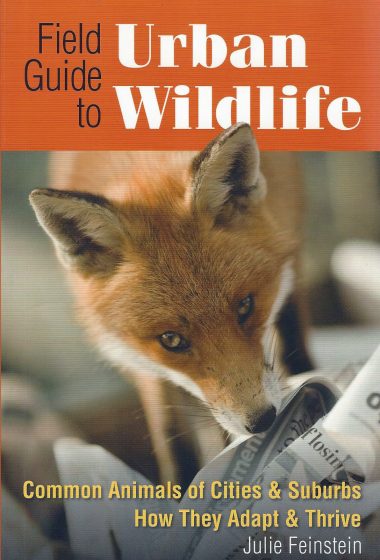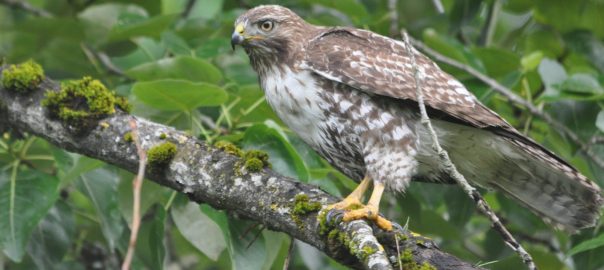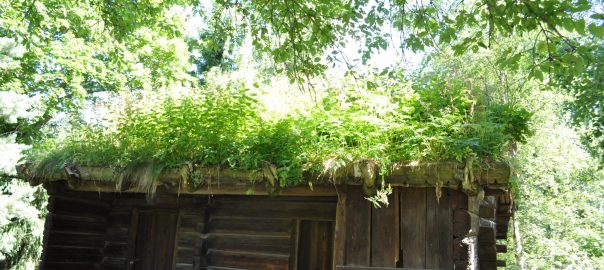A review of Field Guide to Urban Wildlife: Common Animals of Cities & Suburbs How They Adapt & Thrive by Julie Feinstein. 2011. Stackpole Books. ISBN978-0-8117-0585-1. 453 pages. Buy the book.
While it may have set a Guiness record for longest subtitle, Julie Feinstein’s Field Guide to Urban Wildlife caused me to reminisce about a birding class I taught many years ago. It was an in-service teacher’s workshop for novice birders. Having worked in the field with beginning birders for several years, I had become all too familiar with the, “oh, that’s just a…”. Which meant, of course, that the individual had written the bird off with a shrug and a superficial knowledge of the bird’s field marks, habitat, behavior, and individuality.
For the class, I decided that we would not name any bird throughout the daylong workshop. Instead, each time we saw another member of that species, we would assign it the same number. We followed that rigorous protocol all day, even though it was, at times, excruciatingly difficult to resist naming the bird.
By day’s end, we had accumulated a list of 20 species, each entry containing detailed descriptions of field marks, habitat, and behavior. Never again would those teachers mistake a Spotted Towhee for a Robin based on a cursory look at the bird. And never again, I hoped, would they say, “Oh, that’s just a Robin”.

After reading Field Guide to Urban Wildlife, I cannot imagine Julie Feinstein ever saying, “Oh, that’s just a…”; to Feinstein, nothing is common. She makes that very clear from the outset in her introduction, writing, “Though urban animals live among us, sometimes even inside our homes, they largely go unnoticed. They are too commonplace. Yet there are moments, watching a fox in the backyard, discovering a centipede in the bathtub, or finding a bat asleep in the garage, when we wonder about them.”
This book is replete with her sense of wonder, which cannot fail to rub off on her readers, no matter how jaded they may be by the so-called “commonplace.”
The book will be equally appreciated by any “urban naturalist”, whether a rank amateur or seasoned professional, as Feinstein’s field observations and incredibly well-documented research reveal fascinating and illuminating factoids that are by turns humorous and horrifying. Her writing provides us with detailed life histories of everyday urban critters that are also replete with fun trivia, much of it gleaned from extensive literature searches. Meticulous research is Feinstein’s forte—unsurprising, given her professional position at the American Museum of Natural History and her own list of scientific publications.
One example of the obscure details common throughout the book is the revelation that opossums have a maximum land speed of 4 mph and sleep 18 to 20 hours daily, enjoying five hours of REM sleep in the process. She cites another researcher who discovered that taking two male mice and “anointing one of them with a third male’s urine resulted in the anointed mouse starting a fight with its former partner.” And, under an ultraviolet light, “mouse urine glows in the dark like psychedelic art.” We also learn that bathing your dog in tomato juice is not an effective remedy for the dog’s regrettable encounter with the neighborhood skunk. Fortunately, she follows that bit of information, having delved into Chemical Engineering News, with something that actually works to “de-skunk” your dog.

While we all are familiar with the generally friendly, but sometimes fraught, human/squirrel relationship—particularly between humans and the fox and Eastern gray squirrels, which are both the bane of every backyard bird feeder—few readers will know that Ronald Reagan routinely fed squirrels around the White House; indeed, the First Family featured squirrels in their 1984 Christmas cards. President Eisenhower, on the other hand, trapped and deported the squirrels to Maryland after they marred the presidential putting green with myriad holes. Feinstein goes on to describe squirreling counters with other presidents, including Carter, George H. W. Bush, and the Clinton clan, which, in “an era of appeasement”, gardeners provided with “peanut-filled feeders on the South lawn and Rose Garden to draw squirrels away from flower bulbs.” Interesting tidbits aside Feinstein also provides in-depth descriptions of common urban wildlife biology, ecology, and life histories. Such is the case with her descriptions of the fox and Eastern gray squirrels, including a detailed account of their interactions in North America and their invasion of England, where Eastern grays were introduced in the late 1800s.

Feinstein goes into great detail with one of the most common phenomenon that face parents accompanying their children to urban ponds—“ forced extrapair copulations”, or, to put it more bluntly, repeated gang rape of female mallards. While flummoxed parents may not be appreciably assuaged by the information, Feinstein provides detailed information as to the evolutionary strategy for this behavior. She has a great section on Turkey Vultures, including why they defecate on their legs, why they employe projectile vomiting as a defense strategy, why they lack feathers on their heads, that they play a role in the tourist trade at a Georgia state park, and that they have their very own fan club, The Turkey Vulture Society.
Her concluding chapters highlight insects and other arthropods, concluding with earthworms and slugs, subjects all too infrequently discussed in the context of urban wildlife. Among the more fascinating topics she explores are the grooming and mating behavior of centipedes; she even throws in a real groaner of a schoolyard joke on the topic. Given the recent spate of bedbug infestations across the U.S., her chapter on this most reviled pest will be of interest to her readers.
Feinstein’s writing style is user-friendly for the novice but also appealing to the specialist owing to her extensive citations of the scientific literature. The book is filled with high-quality photographs. Finally, she complements the book with her urban wildlife blog, www.urbanwildlifeguide.net, which she updates 4 to 5 times monthly, focusing on holidays such as Mother’s Day and Father’s Day, as well as the changing of the seasons.
I would rate Field Guide to Urban Wildlife as a must-read for urban naturalists of every stripe.
Mike Houck
Portland












There is now plenty of research providing evidence that urban gardens in UK provide more biodiversity than the intensively farmed countryside around our towns and cities. This includes also lots of rare or endangered species, e.g. bats, grass snakes or hedgehogs, not just common species. Having said that, any species is a beautiful creation and good to watch. So for people who do not have any access to the countryside nor Wildlife, even if it is just a common species, they are still of great enjoyment and therefore benefit to observer. Gardens = Green Infrastructure.
Mike thank you for a very interesting review which made me want to read the book. Melinda